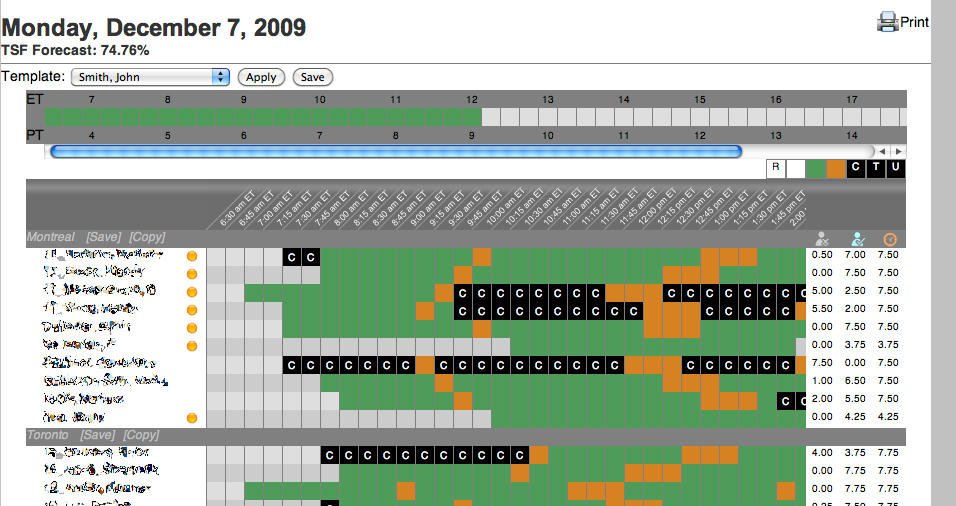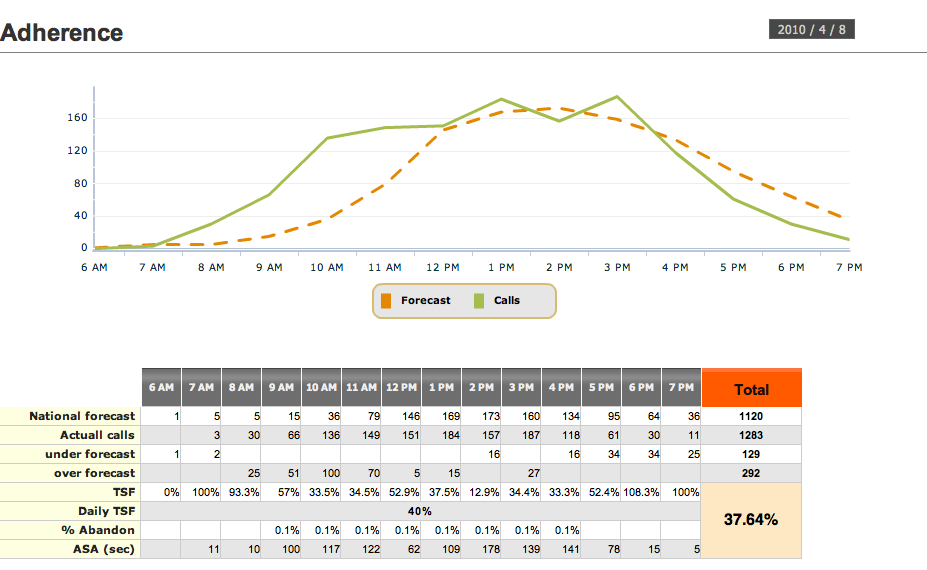Purpose
In late 2009, we were tasked with creating a call center metrics platform that would import Genesys/InterCall phone system data, and:
- Calculate and present call centre metrics, such as telephone service factors (TSF), average handle time (AHT), average wait time (AWT) as well as agent and regional adherence, rates of abandon, and other key performance indicators
- Perform call volume forecasting based on prior year data and project requirements across multiple call centres
- Provide a real-time adherence data to allow fast response to abnormal call volumes
- Allow interactive web-based agent scheduling, forecasting the resulting TSF, allowing managers a simple and instant method to plan for employee breaks, vacations and seasonal call variability
This was potentially one of the most rewarding projects we’ve completed. It took advantage of the mathematical skills of our staff, which is something we had been craving for some time.
Results
The resulting platform is truly unique, in that it leverages data from a third-party source and provides functions the original ought to have.
Forecasting á la NumPy
Since we created an interface to import Genesys data in real-time, it became possible to forecast call volumes based on seasonally adjusted trends and weighting. Although the bulk of this project was written in PHP, it seemed appropriate to extend forecasting into Python (and NumPy): a language and toolset that are much better at linear algebra.
The resulting interface is both powerful and completely extensible in that it allows the NumPy methods to be completely substituted with improved models in real-time, with no other effect on platform function. We shipped with fairly rudimentary forecasting, i.e., no Markov Models, but the ability to substitute more functional models should allow for improved accuracy as new plug-ins are developed.
Integrated Scheduling
The call center manager interface on our platform starts with interactive, instant agent scheduling; what we call the “Workforce” interface:
This interace allows immediate, on-screen scheduling of phone agents, and features:
- Single-click state changes of 15-minute time blocks, as well as status “painting” to quickly schedule agent time. Agent status can be “Phone”, “Break”, “Commitment”, “Training”, or “Union”, providing a detailed view of each agent’s day.
- Instant calculation of Exception, Login and Total agent time (screen shot).
- Agent schedule memory, allowing each agent schedule to be instantly copied week to week.
- Instant regional and national agent load and TSF forecasting (screen shot), providing immediate feedback when making changes.
- Agent availability flagging for vacations, sick-leave and agents on 5/4 schedules.
Workforce scheduling also spans three call regions, and allows simultaneous scheduling across multiple call centres to achieve a superior national service factor.
Reporting
The key measure of effectiveness here is adherence to forecasts, as well as the overall TSF — the percentage of calls that are fielded by agents within a reasonable amount of time.
The Adherence Report
The Adherence Report shows how well the actual call volume matches forecasts (not too well on this date!) and what the resulting TSF has been. This is the key report indicating call center performance. In addition to providing real-time insight into performance indicators, it also allows management to determine what effects, if any, product launches and other initiatives have on call volumes, and to make the adjustments necessary to compensate.
Other Reports
Additional reports include:
- Agent Adherence — a report indicating how well each agent adhered to their own schedule.
- Average Handle Time — shows how the average time taken to complete a calls changed throughout the year
- Frontline — a daily report detailing how well each call center and agent performed, including AWT, ATT., AHT., and Login Time
- Performance — a monthly and weekly report of call volumes, dropped calls and AHT.
The platform is deployed and in-use, providing critical real-time data.


